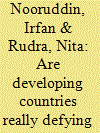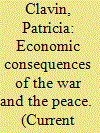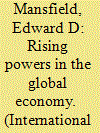|
|
|
Sort Order |
|
|
|
Items / Page
|
|
|
|
|
|
|
| Srl | Item |
| 1 |
ID:
134835


|
|
|
|
|
| Summary/Abstract |
This study evaluates the embedded liberalism hypothesis in a broad swath of less developed countries (LDCs). The authors find that LDC governments pursue a distinct welfare state policy that protects citizens from economic insecurities associated with global market expansion. Specifically, governments use public employment—and particularly employment in civil services and administration—to foster domestic stability alongside market expansion. However, such jobs are targeted to politically salient groups, not poorer groups that might also face increased economic uncertainty postopenness. In turn, public employment shores up public support for openness. The authors' findings suggest that free traders have reasons both to celebrate and to bemoan this LDC embedded liberalism compact. On the positive side, LDC governments are working hard to maintain political support for free trade; on the other hand, the compromise of protecting privileged groups at the expense of others in society raises questions about the long-term sustainability of their strategy.
|
|
|
|
|
|
|
|
|
|
|
|
|
|
|
|
| 2 |
ID:
134980


|
|
|
|
|
| Summary/Abstract |
If international institutions are such potent alarm mechanisms that mobilize procompliance domestic audiences, as many existing theories argue, why do countries wait so long before sounding the alarm? World Trade Organization (WTO) members often wait months or even years before objecting to their trading partners’ WTO-illegal barriers. To turn a phrase, trade cooperation delayed is trade cooperation denied, so why wait? To explain this variation, I develop a theory of institutional alarm mechanisms in which (1) the preferences and strength of the audience hearing the alarm vary and (2) the decision to sound the alarm is strategic. Sounding the alarm is most valuable when strong audiences in the defendant country support compliance. I test this prediction using competing risks models analyzing the timing of WTO disputes against US tariff barriers. Consistent with the theory, disputes are more likely during election years when macroeconomic indicators suggest broader support for free trade.
|
|
|
|
|
|
|
|
|
|
|
|
|
|
|
|
| 3 |
ID:
134567


|
|
|
|
|
| Summary/Abstract |
How do we consolidate developing democratic regimes in the Global South so that the life expectancies of these regimes are considerably sustainable? What have been the key epistemological and normative shortcomings of the mainstream scholarship of democratization? How can we overcome these limitations? Is it necessary to consider the global political economy as a fertile source for deducing some explanatory variables that will help us understand the sources of democratic instability at the national-domestic spheres of political governance? In view of these questions, I contend that there are fundamental limitations in the mainstream scholarship on democratization that we have to overcome. In this essay, I critically appraise the nature of the democratization debate by positing that existing material inequities and injustices in new electoral democracies in the developing world are constitutive of global hegemonic interests that function as the critical determinants of democratic stability. Second, I propose some corrective suggestions that will perhaps inspire a new research agenda about democratization that should overcome the limitations of the current mainstream social science scholarship on democratization. Finally, I articulate some concluding substantive remarks on why we need to bring the global political economy back into our scholarly analyses of democratic consolidation.
|
|
|
|
|
|
|
|
|
|
|
|
|
|
|
|
| 4 |
ID:
134557


|
|
|
|
|
| Summary/Abstract |
In 2021 Russian-Chinese Treaty on Good-Neighborliness and Friendly Cooperation may be not just extended but transformed into a format that would be close to an alliance. So, Russia’s equidistance from the United States and China in the geopolitical triangle is hardly possible in the foreseeable future.
|
|
|
|
|
|
|
|
|
|
|
|
|
|
|
|
| 5 |
ID:
136771


|
|
|
|
|
| Summary/Abstract |
Many developing countries are going through a stretch of market reforms and liberalization in their economic relations with the rest of the world, and yet few of them have advanced anywhere near China in this field. The reasons are very likely in the way they are reforming their economies and in how far they are going in giving consideration to the local and outside environments.
|
|
|
|
|
|
|
|
|
|
|
|
|
|
|
|
| 6 |
ID:
136508


|
|
|
|
|
| Summary/Abstract |
Far from being a "First World problem," mental illness is a global scourge that affects people of all incomes and backgrounds. By 2030, mental disorders will cost the global economy around $6 trillion a year—more than heart disease
Four years ago, a team of scholars from the Harvard School of Public Health and the World Economic Forum prepared a report on the current and future global economic burden of disease. Science and medicine have made tremendous progress in combating infectious diseases during the past five decades, and the group noted that noncommunicable diseases, such as heart disease and diabetes, now pose a greater risk than contagious illnesses. In 2010, the report’s authors found, noncommunicable diseases caused 63 percent of all deaths around the world, and 80 percent of those fatalities occurred in countries that the World Bank characterizes as LOW INCOME or middle income. Noncommunicable diseases are partly rooted in lifestyle and diet, and their emergence as a major risk, especially in the developing world, represents the dark side of the economic advances that have also spurred increased longevity, urbanization, and population growth. The scale of the problem is only going to grow: between 2010 and 2030, the report estimated, chronic noncommunicable diseases will reduce global GDP by $46.7 trillion.
|
|
|
|
|
|
|
|
|
|
|
|
|
|
|
|
| 7 |
ID:
136124


|
|
|
|
|
| Summary/Abstract |
The possibilities of club monetary interaction mechanisms are very modest as they do not replace but supplement global mechanisms. Nevertheless, they deserve attention and support. Equally important is the fact that such mechanisms may have side effects, namely, general shifts in the structure of global economic governance.
|
|
|
|
|
|
|
|
|
|
|
|
|
|
|
|
| 8 |
ID:
135238


|
|
|
|
|
| Summary/Abstract |
The modern, globalized economy had emerged with vigor and reach in the nineteenth century, but was no more a guarantor of domestic or world peace after 1918 than it had been in 1914
|
|
|
|
|
|
|
|
|
|
|
|
|
|
|
|
| 9 |
ID:
136610


|
|
|
|
|
| Summary/Abstract |
What accounts for the spread of Sovereign Wealth Funds (SWFs)? Despite the increasing importance of SWFs in the global economy, we lack persuasive systematic answers to that question. Most analysts take for granted that economic imperatives drive the creation of SWFs; governments create them as effective solutions to the challenges generated by reserve accumulation and commodity-export specialization. In this article, I argue that the evidence fails to support this theory. Instead, the spread of SWFs best resembles the diffusion of a fashion or fad. SWFs became fashionable as an appropriate approach for reserve- and resource-rich countries seeking to manage policy uncertainty related to these economic characteristics. As other countries developed the same characteristics, they followed the lead of their peers and also created SWFs. I provide, with the use of a new data set, the first cross-national political-economy statistical analysis of SWF creation. The results suggest peer group emulation has, indeed, been crucial in shaping the decision of many countries to create SWFs—especially in fuel-exporting countries.
|
|
|
|
|
|
|
|
|
|
|
|
|
|
|
|
| 10 |
ID:
136787


|
|
|
|
|
| Summary/Abstract |
The optimist views South Asia as a half-full glass while the pessimist views it as half-empty. The realist, however, drinks the water in the glass, and wisely quenches his thirst. If we remain stuck in a quagmire of despondency over runaway population growth, grinding poverty of a huge section of the population, and endless squabbles over historic wrongs, the future looks grim. But, if we think of the region as overwhelmingly youthful, charged with vitality and a can-do mentality, well-integrated into the global economy thanks to its large diaspora, brilliantly positioned between the energy rich West Asia and the manufacturing hub of East and South-East Asia, and fully committed to inclusive developmental goals, then South Asia can be the region of the future.
|
|
|
|
|
|
|
|
|
|
|
|
|
|
|
|
| 11 |
ID:
136663


|
|
|
|
|
| Summary/Abstract |
The growing international influence of so-called emerging powers has had a major impact on global governance, leading to new challenges for established and emerging powers alike. This contribution outlines the expectations of established powers and the debates on the state of global governance in the field of International Relations, as well as the positions and policies of emerging powers. An analysis of the fields of TRADE and climate policy highlights the resilience of established powers and reveals that emerging powers, despite their declared reluctance, have actively participated in global governance to pursue their interests. While cooperation is difficult, confrontation is not inevitable.
|
|
|
|
|
|
|
|
|
|
|
|
|
|
|
|
| 12 |
ID:
134930


|
|
|
|
|
| Summary/Abstract |
Today India is considered to be a major player in the emerging global balance of power. It is also emerging as one of the centres of the modern global economy. One of the major aspects of India's foreign policy in the post-Cold War period is its increasing economic, political and strategic engagement with the Asia-Pacific region, or India's 'Look East Policy'. However, India's eastward expansion has not yet resulted in substantial strategic or economic relationship with New Zealand. There is ample scope for New Zealand to enhance this relationship, particularly in strategic and security co-operation, to deal with the emerging challenges from traditional and non-traditional sources in the region.
|
|
|
|
|
|
|
|
|
|
|
|
|
|
|
|
| 13 |
ID:
134500


|
|
|
|
|
| Summary/Abstract |
India's behavior in the global economy has transformed considerably, consistent with its embrace of economic globalization and deregulation since 1991. Until then, India had practiced a type of economic engagement that Stephen Krasner (1985) characterized as structural conflict. Its capacity to tax citizens was dismal. Its trade as proportion of gross domestic product (GDP) hovered around 16% in the 1980s, impeding growth. And, economic resources were redistributed authoritatively rather than through trade. India, like many developing countries, was locked in economic conflict with the West until the 1980s. Since then, it has embraced global economic integration, contributing to surging economic growth. An economy that grew at an average of 3.5% between 1956 and 1975 has grown at more than 6% since 1980 and over 7% since 2004. India is one of the fastest growing economies in the world after China, and the gap between the two countries is shrinking.
|
|
|
|
|
|
|
|
|
|
|
|
|
|
|
|
| 14 |
ID:
135782


|
|
|
|
|
| Summary/Abstract |
This article argues that the tenure of left-wing governments in Israel in the past 40 years has been associated with faster socio-political globalization, while the tenure of right-wing ones has been associated with slower socio-political globalization. In contrast, the pace of Israel's economic globalization and the rise in its average income are found to have been unrelated to the government's political bias. Interestingly, income inequality is found to be unrelated to changes in average income or to government bias with regard to globalization. However, income inequality is found to have risen under governments with a hawkish military bias.
|
|
|
|
|
|
|
|
|
|
|
|
|
|
|
|
| 15 |
ID:
137024


|
|
|
|
|
| Summary/Abstract |
Since the end of the Cold War, Western powers have frequently used sanctions to fight declining levels of democracy and human rights violations abroad. However, some of the world’s most repressive autocracies have never been subjected to sanctions, while other more competitive authoritarian regimes have been exposed to repeated sanction episodes. In this article, we concentrate on the cost–benefit analysis of Western senders that issue democratic sanctions, those which aim to instigate democratization, against authoritarian states. We argue that Western leaders weight domestic and international pressure to impose sanctions against the probability of sanction success and the sender’s own political and economic costs. Their cost–benefit calculus is fundamentally influenced by the strength of trigger events indicating infringements of democratic and human rights. Western sanction senders are most likely to respond to coups d’état, the most drastic trigger events, and tend to sanction vulnerable targets to a higher extent than stable authoritarian regimes. Senders are also more likely to sanction poor targets less integrated in the global economy and countries that do not align with the Western international political agenda, especially in responding to ‘weaker’ trigger events such as controversial elections. The analysis is carried out using a new dataset of US and EU sanctions against authoritarian states in the period 1990–2010.
|
|
|
|
|
|
|
|
|
|
|
|
|
|
|
|
| 16 |
ID:
137148


|
|
|
|
|
| Summary/Abstract |
Since its institutional birth in 1947, the General Agreement on Tariffs and Trade (GATT) / World Trade Organization (WTO) has mushroomed from 23 original contracting parties to 157 members as of September 2012. Another 28 countries are currently observers, each at varying stages of the accession process. WTO members and observers cover some 99 per cent of the world's population and over 99 per cent of global trade. However, there are still 13 states outside the multilateral rules-based trading system. This paper argues that existing explanations of membership and accession do not fully explain why these states remain outside the WTO, with implications for membership in international institutions generally. The paper tests hypotheses of non-membership based on a lack of willingness (domestic support), ability (technical capacity) or external pressure, and augments these statistical findings with a comparative country-level narrative of WTO (non-)accession decision-making in two small island countries.
|
|
|
|
|
|
|
|
|
|
|
|
|
|
|
|
| 17 |
ID:
134495


|
|
|
|
|
| Summary/Abstract |
Over the past 20 years, social scientists, government officials, and investors have expressed mounting interest in the BRIC countries, which include Brazil, Russia, India, and China.2 This acronym was originally coined in 2001 by a Goldman Sachs official who was concerned with the increasing role these countries were playing in global finance (Hounshell 2011). Recently, there has been a growing recognition that the effects of the BRICs on the global economy are not limited to finance. It is also clear that these countries are key political actors: all but one of them possess nuclear weapons, they are regional powers, and many observers view China as a potential challenger to the United States in global political-military affairs.
|
|
|
|
|
|
|
|
|
|
|
|
|
|
|
|
| 18 |
ID:
137122


|
|
|
|
|
| Summary/Abstract |
Economic cooperation and integration became a part of the SAARC work agenda when the council of ministers of the member countries signed an agreement to form the South Asian Preferential Trade Agreement (SAPTA) in April 1993. The move was prompted by a desire of the South Asian economies to dismantle trade barriers following unilateral trade liberalisation as part of the systemic economic reforms initiated, first, in India, and later undertaken by other economies of the region. The economic reforms set the tone for both, a greater global integration of the South Asian economies as also increased growth momentum in the region. In the subsequent two decades, South Asia experienced high growth averaging over 5 per cent annually accompanied by a rapid pace of trade integration with the global economy. The rate of global trade integration of South Asia was the fastest among all regions in the world between 2005 and 2007.
The Indian economy emerged as the second fastest growing economy in the world. The economic dynamism and rapid global trade integration did not, however, translate into a higher level of economic integration among the South Asian economies; and intra regional trade remained at a low of around 5 per cent of the region’s total trade. The region, endowed with geographical, historical, cultural and linguistic proximity- all parameters that make the member economies the most natural trading partners, is today the least integrated region in the world. The process of economic integration in South Asia is marked by many contradictions. These are discussed below followed by the compelling regional and global imperatives to accelerate the pace of economic integration in South Asia. Finally, sub regionalism is presented as a possible way forward for regional cooperation in South Asia.
|
|
|
|
|
|
|
|
|
|
|
|
|
|
|
|
| 19 |
ID:
134551


|
|
|
|
|
| Summary/Abstract |
Creating substituting production capacities, operating a semi-isolated financial system, spending resources to overcome trade barriers and looking for new markets will require enormous and unjustified expenditures, which will inevitably affect the competitiveness of Russia’s national economy and lead to the impoverishment of the population.
|
|
|
|
|
|
|
|
|
|
|
|
|
|
|
|
| 20 |
ID:
135293


|
|
|
|
|
| Summary/Abstract |
This article argues that 1945 constitutes an historical inflection point from a period of state expansion to state contraction and that this transformation is primarily the result of changes at the international level. Just as security and economic pressures drove lead states to expand in earlier times, changing conditions in the post-1945 period led to a contraction in state size. The change from multipolarity, the development of the territorial integrity norm, the shift to nuclear deterrence, and the burgeoning global economy contributed to the milieu in which states evaluate the costs and benefits of holding territory, and this has enabled states to permit secession more frequently. The result has been an increase in the rate of peaceful secession and a corresponding proliferation in the number of sovereign states. I test this argument both qualitatively and quantitatively using original data on secessionist movements and internal administrative regions between 1816 and 2005.
|
|
|
|
|
|
|
|
|
|
|
|
|
|
|
|
|
|
|
|
|